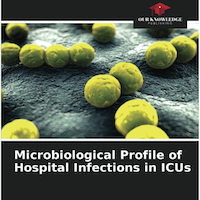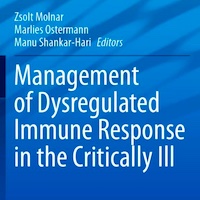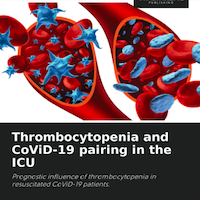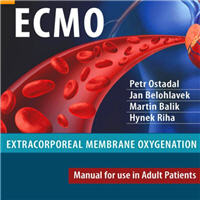Tag: infection
Microbiological Profile of Hospital Infections in ICUs
Hospital-acquired infections are a serious public health problem, leading to increased morbidity and mortality among patients admitted to intensive care units, complications related to health care, as well as longer hospital... read more

Management of Dysregulated Immune Response in the Critically Ill
This book, part of the European Society of Intensive Care Medicine (ESICM) textbook series, deals with dysregulated host response a relatively new term introduced by the Sepsis-3 definitions in 2016. In contrast to systemic... read more

Thrombocytopenia and COVID-19 pairing in the ICU: Prognostic influence of thrombocytopenia in resuscitated CoViD-19 patients
CoViD-19 is a viral zoonosis caused by the coronavirus strain (SARS-CoV-2), with acute respiratory failure being its most severe manifestation. Our aim was to determine the influence of thrombocytopenia on the severity and... read more

Distinct Immune Profiles and Clinical Outcomes in Sepsis Subphenotypes Based on Temperature Trajectories
Sepsis subphenotypes identified using the universally available measurement of body temperature had distinct immune profiles. Hypothermic patients, who had the highest mortality rate, also had the lowest levels of most pro-... read more
Octenidine Bathing Effective in Preventing ICU-acquired Primary Bacteremia
EFFECT has demonstrated that octenidine is effective at preventing primary bacteremia. The emphasis lies among Gram-positive bacteria and common skin commensals. As part of a robust bundle strategy, octenidine can serve... read more
Blood Eosinophils Matter in Post-COVID-19 Pneumonia
Preliminary results showed that a eosinophil increase during hospitalization could be a potential predictor of pulmonary sequelae in surviving patients after COVID-19 pneumonia. Despite the protective role of eosinophils,... read more
Ineffectiveness of Therapeutic Plasma Exchange – Last Resort in Severe COVID-19
Patients severely infected with SARS-CoV-2 showed fluctuations in inflammatory parameters despite TPE treatment; CRS was not suppressed by TPE; and this treatment did not confer survival benefit in this patient group. A... read more
CDC Reports Rising Levels of Mycoplasma Pneumonia and RSV in Young Kids
Though the nation’s respiratory disease levels remain low overall, with COVID levels declining and little sign of a flu uptick, illnesses caused by Mycobacterium pneumoniae are increasing, especially in children, and respiratory... read more
Disease Progression Associated Cytokines in COVID-19 Patients with Deteriorating and Recovering Health Conditions
Understanding the immune response to COVID-19 is challenging due to its high variability among individuals. To identify differentially expressed cytokines between the deteriorating and recovering phases, we analyzed the Electronic... read more
The Impact of COVID-19 Pandemic on Respiratory Syncytial Virus Infection in Children
We observed a lower incidence of RSV infection and a lower rate of hospitalization for RSV during the COVID-19 pandemic. The second RSV season during the COVID-19 pandemic began earlier, lasted longer, and had a lower frequency.... read more
Prediction Model for Safe Early Discharge of Patients with an Infection
By combining readily available parameters, we developed and internally validated a prediction model for safe, early discharge among patients. Further research, preferably in a multi-center setting, is warranted to externally... read more
Tele-ICU Rounds Ineffective in Shortening ICU Stay for Patients
Daily multidisciplinary rounds conducted by a board-certified intensivist through telemedicine do not reduce intensive care unit (ICU) length of stay (LOS) in critically ill adult patients, according to a study published... read more
Presepsin Does Not Predict Risk of Death in Sepsis Patients Admitted to the ICU
In patients with suspected sepsis admitted to the Intensive Care Unit, presepsin does not accurately predict the risk of in-hospital death, but it can predict a positive microbiological culture. Adult patients were included... read more
Procalcitonin and Neutrophil to Lymphocyte Ratio Trends in ICU Sepsis Patients
Understanding the trends of PCT and NLR concerning the infection source can provide deeper insights into their diagnostic and prognostic capabilities. This comparative analysis of PCT, NLR, and SOFA score trends contributes... read more
Half of Sepsis Patients Face Death Within Two Years
Half of all patients with sepsis admitted to an emergency medical department died within two years, according to Danish researchers investigating factors that could predict outcomes for these patients. Dr. Finn E. Nielsen,... read more
Army Scientists’ Technique for Early Sepsis Detection in Burn Patients Submitted to FDA
A new invention developed at the U.S. Army Medical Research and Development Command uses an artificial intelligence machine learning algorithm to identify whether burn patients are at risk of experiencing life-threatening... read more
Early sodium bicarbonate therapy for critically ill patients with septic shock and acute moderate metabolic acidosis
In recent decades, septic shock has continued to be a life-threatening health problem around the world. Meanwhile, metabolic acidosis (MA) is also well known in critically ill patients, and even moderate metabolic acidosis... read more
Optimal Antibiotic Treatment Duration of Upper and Lower Respiratory Tract Infections
The available evidence for non-ICU community-acquired pneumonia (CAP) and chronic obstructive pulmonary disease (AECOPD) supports a short-course treatment duration of 5 days in patients who have clinically improved. Efforts... read more
Non-invasive vs. Arterial Pressure Monitoring in the Pre-hospital Critical Care Environment
Non-invasive blood pressure measurements are often inaccurate within the pre-hospital critical care setting, particularly in patients with hemodynamic instability which are the group in which the accuracy of vital signs is... read more
Sepsis Mortality Prediction in ICU Patients Using Machine Learning
This study has achieved significant advancements in predicting sepsis outcomes by utilizing advanced machine learning techniques and sophisticated data preprocessing methods. These methods include data grouping and effective... read more
Ventilator-associated Pneumonia Risk Factors in Patients with Severe COVID-19
Patients with COVID-19 are at high risk of VAP, which may be related to issues other than prolonged mechanical ventilation (MV) time. Multiple factors increase the chances of these patients developing VAP, including:... read more
Clinical Examination Skills in the Adult Critically Ill Patient
This well-illustrated book provides detailed guidance on all aspects of physical examination in patients requiring emergency or intensive care. After an introductory section covering basic principles and the recognition of... read more










